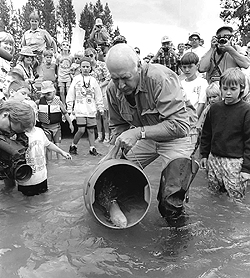forum
library
tutorial
contact

Risch says Save the Sockeye
by Rocky BarkerIdaho Statesman, June 15, 2006
|
the film forum library tutorial contact |

|
Risch says Save the Sockeyeby Rocky BarkerIdaho Statesman, June 15, 2006 |
Conservation council votes to expand hatchery program
after governor says, 'We need to do more, not less.'
 A plan to expand a program that grows Redfish Lake's endangered sockeye salmon in captivity won support Wednesday, despite a scientific panel's call to kill the program.
A plan to expand a program that grows Redfish Lake's endangered sockeye salmon in captivity won support Wednesday, despite a scientific panel's call to kill the program.
The Northwest Power and Conservation Council recommended expanding the Eagle Hatchery and the Oxbow Hatchery in Oregon to increase the output of sockeye salmon for release in the central Idaho lake. The council's recommendation goes to the Bonneville Power Administration, which already supports the $2.75 million expansion to be paid by BPA ratepayers.
Construction on the Eagle Hatchery, which accounts for $2.5 million of the funding, is scheduled to begin this fall. The Idaho Department of Fish and Game will erect a new building with new broodstock, incubation and rearing facilities for raising young sockeye. The council's unanimous vote came after Idaho Gov. Jim Risch urged its eight members to support expansion.
"I think we need to do more, not less," Risch said. But the 11-member Independent Science Review Panel, charged to review BPA-funded programs, said downstream threats like dams, predators and fishing, coupled with reduced genetic resiliency in the small sockeye population, make the program ineffective.
Risch praised the science panel for its review but said the sockeye program needs more time and even more effort before the Pacific Northwest can give up on the fish. The precarious state of the sockeye became clear to him when he was deciding whether to step in and fix a levee on Eagle Island in May, he said. Fish and Game officials explained to him that the sockeye program was based at the Eagle Hatchery.
"I don't need to tell you what would have happened if the water breached through the fish hatchery," Risch said. "The sockeye population would have been lost." Risch also said more needs to be done outside the Stanley Basin to save the sockeye, including reducing incidental harvesting by Columbia River fishermen.
The science panel said the sockeye already may have lost the genetic fitness to survive even if the rest of their ecosystem were to be fixed. That assertion only underscores that the nearly $30 million spent on the program has been a risky investment for the region, said the power council's chairman, Tom Karier of Washington. "Sometimes you make high-risk investments," Karier said.
Salmon advocates said they support the program but criticized the council and the region for not taking more action to address the dams that hinder sockeye migration.
"To save the sockeye, and to save money in the long run, we need to get these fish off artificial life-support and restore the river habitat they need to recover," said Michael Garrity, who works on Pacific salmon issues for American Rivers, a national environmental group. The sockeye captive breeding and rearing program took the last wild, endangered Snake River sockeye out of the wild and raised their progeny in hatcheries. The program is designed to preserve the unique genetic qualities of the fish. The sockeye swim 900 miles from the Pacific and climb 6,500 feet above sea level to spawn in Redfish and two other lakes near Stanley.
The program generates about 160,000 smolts -- migration-ready young salmon -- that are washed in the spring from the central Idaho lake, down the Salmon River, into the Snake and the Columbia and finally the Pacific if they are lucky. The expansion would increase the annual smolt output to 260,000. In its best year, 2000, the program produced 257 returning adults -- the program's annual goal once the expansion is complete. In 2005, only six sockeye returned.
The Bonneville Power Administration markets power from federal hydroelectric dams throughout the Columbia Basin and funds fish and wildlife programs to offset the impacts of the dams. BPA's customers include rural electric cooperatives in Idaho and the city of Idaho Falls.
The Northwest Power and Conservation Council coordinates BPA's fish and wildlife funding programs and makes recommendations on where to spend on salmon restoration programs. The council is appointed by the governors of Idaho, Montana, Oregon and Washington.
learn more on topics covered in the film
see the video
read the script
learn the songs
discussion forum
